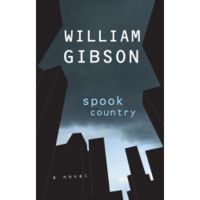Spoiler Alert
 Last weekend I read William Gibson’s new book, Spook Country. Like most of Gibson’s book he does a great job imagining the evolution of computing technologies. He is the master of close-future forecasting. In this case he looks at GPS (Global Positioning System) or, more specifically its use for what is called locative art or augmented reality. One of the parallel plots of the story has the main character Hollis follow an artist and look (through a special visor) at virtual works superimposed over real locations like F. Scott Fitzgerald’s death where it really happened. Gibson in Q&A with the Boston Globe calls it graffitti (compared to current locative art which is mostly audio-cellphone based.) Gibson has put his finger on something important – the way GPS and WiFi enable an outdoor virtual reality superimposed on where you are.
Last weekend I read William Gibson’s new book, Spook Country. Like most of Gibson’s book he does a great job imagining the evolution of computing technologies. He is the master of close-future forecasting. In this case he looks at GPS (Global Positioning System) or, more specifically its use for what is called locative art or augmented reality. One of the parallel plots of the story has the main character Hollis follow an artist and look (through a special visor) at virtual works superimposed over real locations like F. Scott Fitzgerald’s death where it really happened. Gibson in Q&A with the Boston Globe calls it graffitti (compared to current locative art which is mostly audio-cellphone based.) Gibson has put his finger on something important – the way GPS and WiFi enable an outdoor virtual reality superimposed on where you are.
What I find dissappointing is the increasing predictable passivity of Gibson’s characters. In Spook Country he has three witness zombie characters who essentially move around the plot watching the real protagonists and reflecting on them. That Hollis would by sheer luck (and her having been part of a defunct band) get invited to witness and talk to the protagonists becomes unbelievable at the end. I can see no reason why either Bigend or the old man would involve her as they do based on Gibson’s prose. Likewise the character Milgrim is dragged along to witness the far more interesting character Brown. The strange passivity of such central characters spoils an otherwise very smart book. Gibson is trying too hard to avoid a third-person point-of-view so he creates unbelievable witnesses.
One thing Gibson does well is science fiction of the here-and-now. Spook Country takes place after 9/11 and in the shady reality of contract intelligence. It reflects in the way that speculative fiction can on what we are worried we will become. Washington Post reviewer Bill Sheehan rightly compares Gibson to Don DeLillo, both of whom write “fiction that is powerfully attuned to the currents of dread, dismay and baffled fury that permeate our culture.”